Today from La Spezia, Italy, we close out the week with the following stories...
Have a safe weekend!
Tom
-
Air Force plane crashes in SE Oklahoma City, no injuries
by: Terré Gables/KFOR
UPDATE: 5:52 p.m. An Air Force officer on the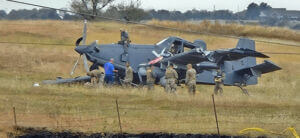 scene says this was an Air Force plane. The plane is a new plane model the air force introduced a few months ago as a heavily armed crop duster. The training program is based out of Will Rogers Air National Guard Base at OKC Will Rogers International Airport.
scene says this was an Air Force plane. The plane is a new plane model the air force introduced a few months ago as a heavily armed crop duster. The training program is based out of Will Rogers Air National Guard Base at OKC Will Rogers International Airport.
According to Air Force officials, the plane took off from Will Rogers and was just flying around the area for training and would have returned to Will Rogers to land when they were finished.
The Air National Guard is the lead agency on the scene and says everyone on board is uninjured.
Update: 4:36 p.m. The Oklahoma National Guard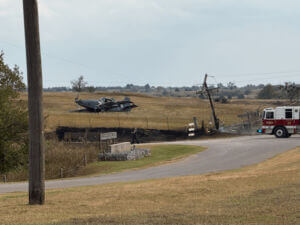 reports an Air Force OA-1K Skyraider II crashed near SE 119th and S. Sooner Thursday afternoon.
reports an Air Force OA-1K Skyraider II crashed near SE 119th and S. Sooner Thursday afternoon.
Two crew members were on board, one civilian contractor and one U.S. Air Force active duty member.
No injuries are reported.
The aircraft was assigned to the 492d Special Operations Wing and operated out of Will Rogers Air National Guard Base.
The investigation into what happened is ongoing.
ORIGINAL STORY:
OKLAHOMA CITY (KFOR) – Oklahoma City Fire Department confirms a emergency involving an Air National Guard plane at SE 119th and Sooner Road.
So far, scanner traffic indicates no injuries.
https://kfor.com/news/national-guard-plane-lands-in-se-okc/
Lone occupant rescued from small plane crash in marsh near St. Augustine Airport
Scott Butler - Jacksonville Florida Times-Union
The lone occupant of a small plane that crashed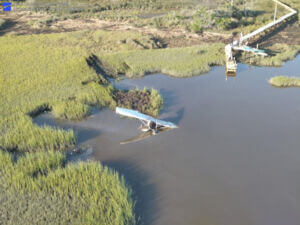 in a marsh north of St. Augustine Airport was in stable condition after quick-thinking firefighters got her to safety, according to St. Johns County Fire Rescue.
in a marsh north of St. Augustine Airport was in stable condition after quick-thinking firefighters got her to safety, according to St. Johns County Fire Rescue.
It happened about 8 a.m. Thursday, Oct. 23, near Redfish Creek Drive. A Fire Rescue deputy chief heading to work saw the plane veering to the right and then some flight tower and 911 calls started coming in, so he responded to the area, public information officer Chris Naff said.
"Right behind him was a battalion chief who ― he was on duty but on his way to a class ― came down the dock, saw a kayak off to the side, grabbed that and basically threw the kayak into the water, went out to the plane, got the lady out of the plane and brought her back where we could get her treatment."
The Florida Highway Patrol is leading the investigation. The cause has not been determined, but the Highway Patrol listed the woman as a 20-year-old student pilot.
https://eu.jacksonville.com/story/news/crime/2025/10/23/pilot-survives-small-plane-crash-in-marsh-near-st-augustine-airport/86851873007/
Pilot escapes with minor injuries after plane crash at Flippin airport
By: Sammy Raycraft
Emergency crews responded to a single engine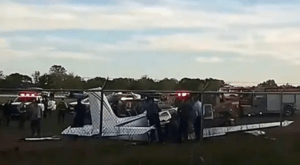 plane crash at the Marion County Regional Airport outside of Flippin Thursday evening.
plane crash at the Marion County Regional Airport outside of Flippin Thursday evening.
According to Marion County Office of Emergency Management Director Melissa Penn, the aircraft had just taken off around 5:15 when the pilot reported engine trouble and attempted to turn back to the runway. The plane crashed inside the airport fencing area.
Penn says the pilot, who was the only person on board, sustained minor injuries and was taken to Baxter Health in Mountain Home for treatment. The Flippin Fire Department extricated the pilot from the aircraft.
There was no fire reported at the scene, though Penn noted that risk is always a concern with any aircraft incident.
Responding agencies included the Flippin Fire Department, Fairview Fire Department, Rea Valley Fire Department, Marion County Sheriff’s Office, Flippin Police Department, Arkansas State Police, and Marion County OEM.
The Federal Aviation Administration has been notified and is expected to investigate the cause of the crash.
Penn commended local responders for their quick and coordinated response, saying their efforts ensured the pilot’s safety.
Toxic 'forever chemicals' remain at former Rantoul Air Force base
Doug Wolfe
RANTOUL, Ill. (WAND) – Chanute Air Force Base in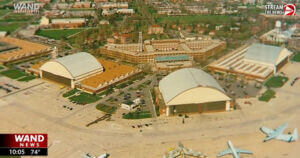 Rantoul closed in 1993. Thirty-two years later, the Air Force is trying to determine where so-called forever chemicals, PFAs, are located and how to handle them.
Rantoul closed in 1993. Thirty-two years later, the Air Force is trying to determine where so-called forever chemicals, PFAs, are located and how to handle them.
“I will literally die with large amounts of PFAs remaining in my blood because it doesn’t break down,” veteran Kevin Ferrara, a former Air Force firefighter who served at Chanute, told WAND News. “This stuff is man-made. It’s not natural. It should not be in our blood, and that’s 30 years after I went to Chanute.”
Chanute was in firefighter training school, which used a firefighting foam known as AFFF, an effective foam used in battling aircraft fires. Those training with it, or using it in actual fires, did not realize that AFFF was toxic, possibly linked to cancer and other health issues.
“We were told firefighting foam, it’s perfectly safe. It’s soap and water, and we took it at that,” Ferrara stated. “It stays in the environment forever. Stays in your blood forever. And it’s scary. It’s scary stuff what this stuff does.”
Ferrara is currently the CEO of AFSO21, LCC, and is an advocate for health and safety as well as environmental protection. He has 36 years of fire service experience and serves on numerous boards and committees associated with firefighter health and safety, military exposure to toxic chemicals, and cancer research and education.
Paul Carrol is with the Air Force, which is investigating several sites on the former Chanute base to see exactly where PFA’s contamination is located. He told WAND News the Air Force has taken 496 groundwater samples from a shallow aquifer and 755 soil samples.
“We get those sites investigated, we’ll determine whether there’s a human health risk or ecological risk at each one of those sites,” Carroll said.
A remedial investigation report is scheduled to be completed in the fall of 2026. Actual clean-up of the contaminated locations will be sometime after that, once the appropriate steps needed are determined.
“It’s just going to be a long, lengthy process to remediate it once we get things started,” Carroll stated.
The Air Force said PFAs have not impacted the Rantoul drinking water supply and have not been found in local wells.
The problem with PFAs is that they tend to migrate and do not stay in one place.
“So, that chain link fence that separates Chanute from the civilian side, that’s not a very good barrier,” Ferrara said.
https://www.wandtv.com/news/wand-investigates/toxic-forever-chemicals-remain-at-former-rantoul-air-force-base/article_56075a14-705e-4129-8ab0-251d99868cb1.html
NTSB Final Report: Cirrus SR22
Postaccident Examination Revealed That The Right Brake Linings Had Exceeded The Manufacturer’S Serviceable Wear Limit
Location: Saginaw, Michigan Accident Number: CEN24LA014
Date & Time: October 6, 2023, 09:45 Local Registration: N969JB
Aircraft: Cirrus SR22 Aircraft Damage: Substantial
Defining Event: Sys/Comp malf/fail (non-power) Injuries: 2 None
Flight Conducted Under: Part 91: General aviation - Personal
Analysis: The pilot was taxiing from the fixed-base operator’s building to the runway. As he increased brake pressure to stop the airplane before the runway hold short line, it turned to the left and completed a full 360° turn before coming to rest. The passenger then offered to try his brake pedals but the airplane only turned to the left; the pilot and passenger concluded they had no control of the right brake. The passenger then observed a fire emanating from under the right wing. The airport’s aircraft rescue and firefighting personnel responded and extinguished a fire associated with the right brake assembly. The right wing’s lower surface sustained substantial thermal damage during the ground fire.
A postaccident examination revealed that the right brake linings had exceeded the manufacturer’s serviceable wear limit. The left brake linings were also significantly worn but within the serviceable wear limit. Additionally, the left brake assembly revealed a darkened temperature indicator sticker that indicated the left brake assembly had previously exceeded the manufacturer’s temperature limitation. The right brake assembly sustained significant thermal damage during the ground fire and its associated temperature indicator stickers were not observed.
The excessively worn brake linings would have resulted in increased brake temperatures being transferred to the brake pressure plate and pistons. The loss of right brake effectiveness and subsequent fire likely occurred when hydraulic fluid leaked past a thermally damaged O-ring installed on one of the right brake pistons, then caught fire when it contacted the hot brake assembly.
Probable Cause and Findings: The National Transportation Safety Board determines the probable cause(s) of this accident to be -- The failure of the right brake assembly due to excessive brake lining wear, which resulted in a thermally damaged piston O-ring, hydraulic fluid leak, and subsequent fire.
FMI: www.ntsb.gov

Today in History
78 Years ago today: On 24 October 1947 United Airlines flight 608, a Douglas DC-6, crashed near Bryce Canyon Airport, UT, USA, following an in-flight fire, killing all 52 occupants.
| Date: | Friday 24 October 1947 |
| Time: | 12:29 |
| Type: | Douglas DC-6 |
| Owner/operator: | United Airlines |
| Registration: | NC37510 |
| MSN: | 42875/17 |
| Year of manufacture: | 1947 |
| Total airframe hrs: | 933 hours |
| Engine model: | P&W R-2800 |
| Fatalities: | Fatalities: 52 / Occupants: 52 |
| Other fatalities: | 0 |
| Aircraft damage: | Destroyed, written off |
| Category: | Accident |
| Location: | 2,4 km SE of Bryce Canyon Airport, UT (BCE) - United States of America |
| Phase: | En route |
| Nature: | Passenger - Scheduled |
| Departure airport: | Los Angeles Airport, CA (LAX/KLAX) |
| Destination airport: | Chicago Municipal Airport, IL (MDW/KMDW) |
| Investigating agency: | CAB |
| Confidence Rating: | Accident investigation report completed and information captured |
Narrative:
United Airlines flight 608, a Douglas DC-6, crashed near Bryce Canyon Airport, UT, USA, following an in-flight fire, killing all 52 occupants.
United Airlines flight 608 departed Los Angeles at 10:23 for a non-stop flight to Chicago. The airplane climbed to 19,000 feet and proceeded VFR over Fontana, Daggett, Silver Lake, Las Vegas, and Saint George. At 12:21 Flight 608 reported that a fire had been detected in the baggage compartment which the crew was unable to extinguish. The report added that the cabin was filled with smoke and that the flight was attempting to make an emergency landing at Bryce Canyon Airport in Utah. The fire had erupted in the center section in the vicinity of the right wing fillet. Small parts of the airplane were lost in flight and at least one of the emergency landing flares which are located at the trailing edge of the right wing fillet ignited in flight.
Shortly thereafter the flight again reported that the "tail is going out-we may get down and we may not." At 12:26 another transmission was received from the flight indicating that it was going into the "best place available." One minute later the flight reported "we may make it-approaching a strip." This was the last contact with the flight. It crashed at 12:29 before it was able to reach the airport.
After the accident, investigators noted that the DC-6 airplane design included a No.3 alternate fuel tank vent outlet that was located on the right side of the fuselage near the leading edge of the wing and close to the bottom wing fillet. Approximately 10 feet aft of this point and slightly to the left there was an air scoop which served as a source of cabin heater combustion air and cooling air for the cabin supercharger air after-cooler and cabin supercharger oil cooler. Flight tests conducted with other model DC-6 aircraft subsequent to the accident revealed that overflow from the No. 3 alternate tank through the air vent line and out the vent outlet would sweep back in the slip stream toward the cabin heater combustion air intake scoop and that a considerable quantity of fuel would enter the scoop. Ground tests clearly demonstrated that, under conditions simulating the entry of fuel overflow into the scoop inflight while the heater was operating, the cabin heater could be expected to backfire and thereby propagate flame downstream into the air scoop. Incoming fuel would, thereafter, be expected to continue to burn in the air scoop and duct.
PROBABLE CAUSE: "The combustion of gasoline which had entered the cabin heater air intake scoop from the No.3 alternate tank vent due to inadvertent overflow during the transfer of fuel from the No.4 alternate tank. The failure of the manufacturer and the Civil Aeronautics Administration to exercise full caution in the analysis of the fuel system of the DC-6 relative to proper location of fuel tank vents to provide non-hazardous location for fuel drainage, as required by existing regulations, and the insufficient attentiveness on the part of the manufacturer, the Civil Aeronautics Administration, and the air carriers to the procedures of fuel management employed by pilots operating DC-6 aircraft, were contributing factors."
